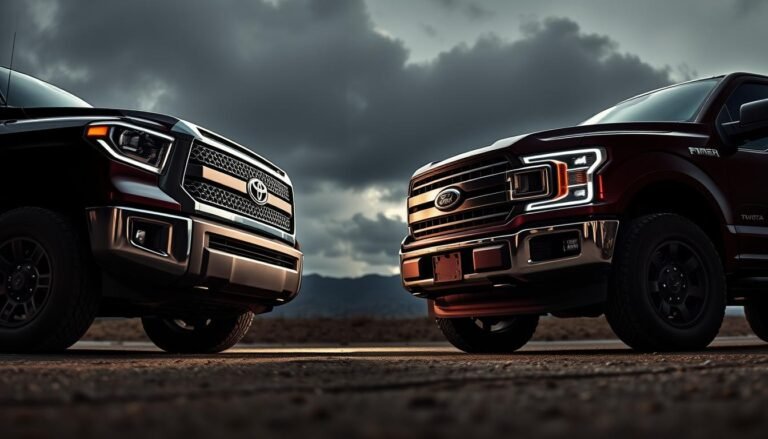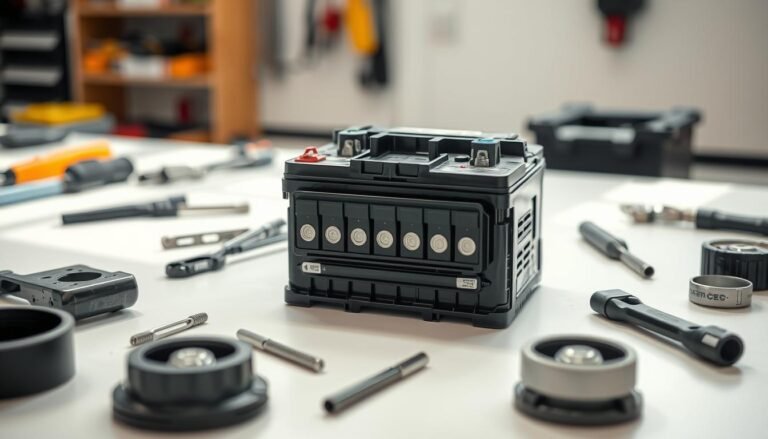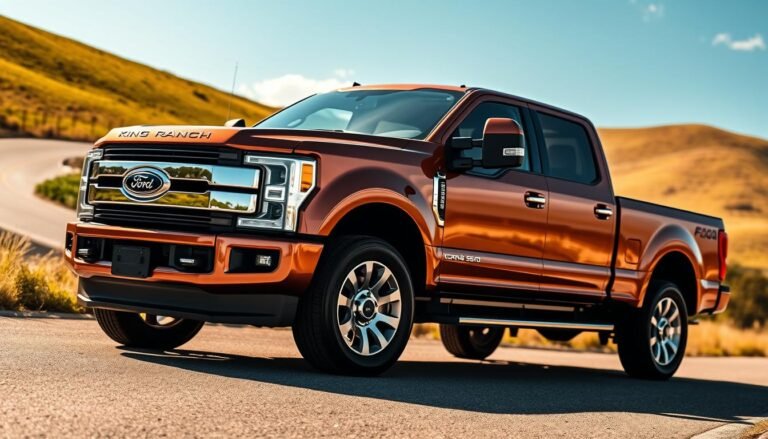What Lug Pattern Is A Ford f150? Best 7 Quick Specs
What lug pattern does a Ford F150 have? For models from 1997 to 2003, it’s 5x135mm (5×5.31 inches). From 2004 to 2023, it changes to 6x135mm (6×5.31 inches).
Knowing the lug pattern of your Ford F150 matters. It helps you pick the right wheels for your truck. This ensures your ride works well and stays safe.
The switch from a 5-lug to a 6-lug pattern happened in 2004. This 6-lug setup has stayed the same up to 2023.
This guide will teach you about your truck’s specific lug pattern and its importance. First, we’ll look at the different lug patterns for various model years.
It’s key to know these patterns when shopping for new wheels. Understanding the bolt pattern, center bore, and lug nut sizes prevents trouble and fit issues.
Introduction To Ford F150 Wheel Specifications
The Ford F150, America’s top-selling truck, has unique ford f150 wheel specifications that change with the model year. Knowing these specs is key for maintenance and upgrades.
If you’re looking to add aftermarket wheels, knowing the f150 wheel requirements is a must for best performance and safety. Most F150 trucks from 2004 onwards follow a 6x135mm bolt pattern.
Here are the specifics:
- Bolt Pattern: 6x135mm
- Center Bore: 87.1mm
- Lug Nut Size: 14mm x 2.0
- Recommended Torque: 150 ft-lbs
For 1997-2003 models, the specs are slightly different:
- Bolt Pattern: 5x135mm
- Center Bore: 87.1mm
- Lug Nut Size: 12mm x 1.75
- Recommended Torque: 100 ft-lbs
F150 trucks usually have a wheel offset from +30mm to +44mm, based on the year and trim.
They need “Load Range E” tires, with each wheel holding up to 3,150 lbs. Sticking to these specs is crucial to prevent tire and handling problems.
What Lug Pattern Is A Ford F150?
The lug pattern of a Ford F150 is crucial. It affects the fitment of various wheel styles on your vehicle.
Knowing the differences between model years is key for upgrades or replacements. There are two main lug patterns throughout the F150’s production history.
Common Lug Patterns For Different Model Years
From 1997 to 2003, F150s have a 5x135mm bolt pattern. This means there are five lug holes in a circle. Starting in 2004 and continuing to 2023, the pattern changed to 6x135mm.
This means the truck now has six lug holes. This was a big change that made the truck stronger and more versatile with wheels.
Always check this when looking for new wheels to make sure they will fit your truck.
Importance of Knowing Your Lug Pattern
It’s very important for F150 owners to know their truck’s lug size. If the wheels you pick don’t match the lug pattern, they won’t fit right. This can damage your truck and the wheels.
Choosing wheels that match your truck’s year and model keeps you safe and ensures your truck performs well. This knowledge can prevent expensive mistakes and help your drive be smoother.

Details of The F150 Lug Patterns by Model Year
The Ford F150 truck has gone through many changes over the years. Each version has its own specific lug patterns, important for their fit and performance. Here, we give an overview of these patterns for different F150 model years.
2004-Present Ford F150 Specs
From 2004 until now, all F150 trucks have a bolt pattern of 6x135mm. They also have a center bore of 87.1mm. Their lug nut size is 14mm x 2.0, and they should be tightened to 150 ft-lbs.
This standard size through the years makes it easier for F150 owners to switch or replace their wheels.
1997-2003 Ford F150 Specs
The F150s made between 1997 and 2003 have a different setup. Their bolt pattern is 5x135mm but the center bore remains the same at 87.1mm.
The lug nut size for these trucks is 12mm x 1.75, with a tightening torque of 100 ft-lbs. Knowing these differences helps truck owners make better choices for their vehicles’ wheels and maintenance.
| Model Year | Lug Pattern | Center Bore | Lug Nut Size | Recommended Torque |
|---|---|---|---|---|
| 2004-Present | 6x135mm | 87.1mm | 14mm x 2.0 | 150 ft-lbs |
| 1997-2003 | 5x135mm | 87.1mm | 12mm x 1.75 | 100 ft-lbs |

Components of A Lug Pattern
Getting the right lug patterns for your Ford F-150 is key. It ensures your wheels fit perfectly.
Knowing this prevents mistakes and boosts your truck’s performance. We’ll explain bolt patterns and show how to measure the Ford F150 lug pattern.
Knowing Bolt Patterns
The lug, or bolt pattern, depends on the number of bolt holes and the space between them. For Ford F-150s from 1997 to 2003, you’ll find a 5-lug pattern.
Its dimensions are 5×5.31 inches (5x135mm). From 2004, the pattern switched to 6-lugs, still measuring 6×5.31 inches (6x135mm). All models have a center bore of 87.1 mm, making wheel fitting flexible.
Measuring The Lug Pattern
To measure the Ford F150 lug pattern, you need to be precise:
- Find the center of two opposite lug bolts.
- Measure the diameter of a circle that would pass through these centers. Use a tape measure or a bolt pattern gauge.
- Aim for a diameter of 5.31 inches for 5-lug setups, and the same for 6-lug ones.
Following these steps ensures you get the right lug pattern for your truck. This secures proper wheel fit and boosts your F-150’s performance.
Knowing lug patterns also helps with maintenance and extends your truck’s life.

How To Ensure Proper Wheel Fitment?
Getting the right fit for your Ford F150’s wheels means looking at wheel offset and center bore specs. The way these parts align has a big effect on how your truck drives and looks.
Wheel Offset Considerations
Knowing the f150 wheel offset is key. For a Ford F150, you want an offset between +30mm and +44mm. This makes sure the wheels sit just right, avoiding any rubbing.
A good offset also keeps your ride smooth and steady, no matter the road conditions.
Center Bore Specifications
The center bore size is also important for wheel fit. All Ford F150 trucks need a center bore of 87.1mm for a perfect fit.
If you go for aftermarket wheels with a bigger bore, you’ll need hub-centric rings. These rings make sure your wheels fit without wobbles, which means better driving.

| Wheel Specs | 5-Lug Pattern (1997-2003) | 6-Lug Pattern (2004-2023) |
|---|---|---|
| Bolt Pattern | 5×5.31″ (5x135mm) | 6×5.31″ (6x135mm) |
| Total Years | 7 years | 20 years |
| Percentage of Years | 25.93% | 74.07% |
Paying attention to these specs will help you improve your F150’s look and performance. It ensures a great driving experience.
Common Problems with Wheel Fitment
Ford F150 owners often face wheel fitment issues. Knowing the most common problems can help you avoid expensive errors and improve your drive. Issues like f150 offset and how lug nuts fit are usually to blame.
Offset Issues Leading To Rubbing
Offset is key for wheel fitment on your F150. The wrong offset, especially with big wheels, can cause rubbing on suspension parts.
The best offset for stock F150s is between +38mm and +44mm. Offsets under +30mm can make wheels stick out too much.
Those over +44mm might rub. Always check offset specs before you buy to dodge these issues.
Lug Nut Seating Problems
Getting lug nuts to fit right is vital for wheel stability. If lug nuts aren’t seated right, wheels can get loose, which is dangerous. Make sure your lug nuts fit the wheel’s seat type, like conical or flat.
Also, tighten your lug nuts again after driving 50 to 100 miles on new wheels. This keeps the fit tight and avoids problems, making your drive safer.
How To Properly Torque Ford F150 Lug Nuts?
It’s very important to torque the lug nuts of your Ford F150 the right way. Not only does this keep you safe, it helps your vehicle run smoothly.
Making sure lug nuts are tight enough stops the wheels from coming off. This also stops the wheels from shaking.
Each Ford F150 model year has different torque needs. So, you should always check what the maker says.
Recommended Torque Values by Model Year
The correct torque numbers for the Ford F150’s lug nuts are listed here:
| Model Year | Torque Value (ft-lbs) |
|---|---|
| 1997-2003 | 100 |
| 2004-Present | 150 |
Best Practices For Torque Application
To make sure lug nuts are just tight enough, you should:
- Use a good torque wrench for precise results.
- Put the torque on in a star pattern. This way, the pressure spreads out evenly.
- First, put on the torque. Then, check it again after driving 50-100 miles. This catches any adjustments needed.
Benefits of Choosing The Right Wheels For Your F150
Choosing the best wheels for your Ford F150 can make your drives better. The right wheels do more than look good.
They boost your F150’s performance and give it a unique style that shows off your taste.
Improving Performance and Handling
Wheels change how your vehicle moves. Choosing alloy wheels over steel ones can make your truck handle better and use less fuel.
They get rid of heat faster, which is great for tough jobs and off-roading. Also, lighter wheels make your truck go faster and stop quicker, making the ride smoother.
Less weight on the wheels means your truck can perform better, especially when towing or driving on rough roads.
Wheels made for off-roading are built to grip the ground better, readying you for any adventure.
Enhancing Aesthetic Appeal
Your Ford F150’s looks can be key, and the right wheels help you make it your own. You can pick from many styles, like the tough Method 305 NV or the sleek American Racing AR23, to boost your truck’s look.
Choices in color, size, and finish, like durable powder coating or special performance designs, let you customize endlessly. The right wheels ensure your F150 reflects your personality perfectly.
Signs You Need To Check Your F150’s Wheel Specifications
If your Ford F150 starts acting differently, like pulling to one side or the steering feels off, it’s time to check the wheels.
These changes in how your truck drives could mean the wheels aren’t aligned right or there’s another issue with them.
Feeling shakes or vibrations when you drive is another sign something might be wrong with your wheels or tires. It’s important to check these things often.
That way, you’ll spot problems like uneven tire wear early. This usually means the wheels aren’t lined up right or they don’t fit properly.
When you’re taking care of your F150, always check the bolt pattern and how tight the lug nuts should be. The usual bolt pattern for a Ford F150 is 6×135 mm.
By keeping an eye on these details, you can avoid bigger problems later on. Here’s a quick summary of key signs that indicate it’s time to check your F150’s wheel specifications:
- Altered handling or steering response
- Unusual vibrations while driving
- Uneven tire wear patterns
- Frequent need for re-torquing lug nuts
Being alert to these signs and checking your truck regularly makes it safer and perform better on the road.
Conclusion
Knowing your Ford F150’s lug pattern and wheel specs is key to keeping your truck safe and running well. The common lug pattern for a Ford F150 is 6x135mm.
This info is crucial when you’re looking to change or upgrade your wheels to make sure they fit perfectly and work as they should.
Understanding wheel specs like bolt patterns, offsets, and how much torque to use is important for installing wheels correctly. For instance, using 150 foot-pounds of torque is recommended.
It prevents the wheels from becoming loose or even coming off while you’re driving. By knowing these details, you can avoid expensive mistakes and make your truck more dependable.
If you’re thinking about getting new wheels, there are plenty of choices out there that can boost your truck’s looks and performance.
Just be sure to check your truck’s specifications carefully before you make any changes. And if you’re not sure about something, it’s always a good idea to ask a professional for help.
Taking these steps will help make sure your wheel upgrade goes smoothly and keeps your Ford F150 in top condition.
FAQs
What is the lug pattern of a 2004-present Ford F150?
The lug pattern for 2004-present Ford F150 models is 6x135mm.
What is the lug pattern of a 1997-2003 Ford F150?
The lug pattern for 1997-2003 Ford F150 models is 5x135mm.
What is the recommended torque for lug nuts on a 2004-present Ford F150?
The recommended torque for lug nuts on 2004-present Ford F150 is 150 ft-lbs.
What lug nut size is required for a 2004-present Ford F150?
The lug nut size for 2004-present Ford F150 models is 14mm x 2.0.
How do I measure the lug pattern of my Ford F150?
To measure the lug pattern, use a bolt pattern gauge or measuring tape. You want to find the circle’s diameter going through the centers of opposite studs.
What is the offset range for a standard Ford F150?
The ideal offset range for a standard Ford F150 is between +30mm and +44mm.
How can I improve my Ford F150’s handling with new wheels?
Choosing the right wheels can improve handling. It does this by keeping alignment right, cutting down weight, and boosting looks. This all leads to better driving performance.
What symptoms should I look for that indicate wheel fitment problems?
Look out for unusual vibrations, uneven tire wear, and steering changes. These signs mean you might have wheel fitment problems.







